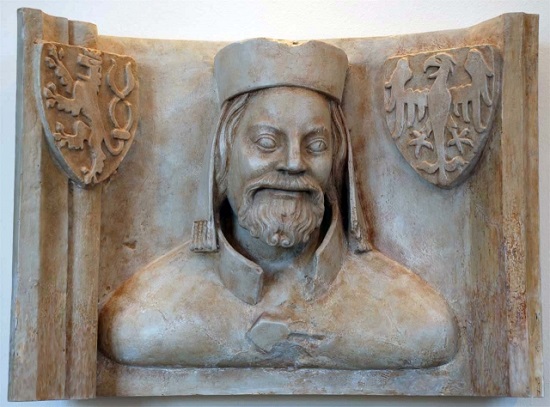By Jan Boukal
Before Charles IV, the kings Přemysl Ottokar II and Wenceslas II had already made their attempts at codification of the land law. However, these attempts were in vain as their were heavily opposed by Czech aristocrats who had no intention to allow the sovereign to curb their authority. The first real land code, thus, should be Codex Carolinus, now incorrectly called Maiestas Carolina. The name Maiestas Carolina, though commonly used these days, was first used as late as 1617 in the version published by Pavel Ješín. As indicated by the name, the main initiator of the code was Charles IV. We don’t know for sure when Charles started working on the draft, together with his counselors. The idea probably rooted in his mind during he was ill in Bohemia between 1350 and 1352. As for the names of his collaborators, we can only guess – most probably they included his future chancellor John of Středa, or Assistant Bishop of Olomouc and later also chancellor and Archbishop of Magdeburg, Dietrich of Portitz (Kagelwit). Around 1353, the first draft was already made, allegedly approved by leading Czech aristocrats at some of the land assemblies later on.

A plaster cast bust of Charles IV at the Prague Castle
However, there was strong opposition after Charles IV had returned from his imperial coronation in Rome in 1355, and presented the second version of the code to the Czech aristocracy. When it became clear that the Czech lords wouldn’t attach their seals to Charles’s code, he wanted to avoid the official rejection, so he invented a story that the code had burned, and so there would be no further discussion about it. This alleged burning of the code was mentioned in a document Charles issued on October 6, 1355. Then, the sovereign and the aristocrats should stick to the old legal customs. But in fact, there was no harm done to Charles’s text, and in the late Middle Ages, it was copied several times and translated to Czech. In the original Latin form, the code has preserved in four complete copies and two incomplete manuscripts.
In making of the code, Charles probably took inspiration from the code issued by Emperor Friedrich II. in Melfi, Italy, in 1231. Charles’s code consists of 109 sections. The way its parts are arranged clearly indicates that it wasn’t the final version of the text. This is, for example, proven by the foreword that follows the first group of sections, focused on the Christian faith and persecution of heresy. Numerous sections aim at strengthening of the royal power. Charles was very unhappy that during the reign of his father John, most royal towns and castles were pawned to the Czech aristocracy. The king should never give his pillars of power away, which is why the Maiestas contains the specific list of towns and castles that should always belong the property of the Kings of Bohemia, and another list of property that only could be pawned temporarily. This part is followed by chapters on administration and justice, maintaining peace and rule of law in the country, defense of the country, management of royal forests, reversionary right, rights of the aristocracy, and sexual ethics. The aristocrats probably primarily opposed to the fact that they should have been under the authority of royal “legal supervisors”, whose task was to see that peace was maintained in the land. Also they certainly didn’t like the sections on public offices, which were not to be inherited, and it was forbidden to sell or pawn them. And the reversionary right was only given to the King of Bohemia, which certainly didn’t please the aristocracy either. Also important are the parts of the code focused on the Bohemian queens. The relevant sections promised them timely coronation, but also forbad the queens-widows to marry aristocrats, unless they gave up the inherited property and left the country. These provisions no doubt reflected on the remarriages of queens-widows Viola of Teschen and Elisabeth Richeza. In addition, Maiestas forbad trials by ordeal using water or iron, and cruel punishments such as eye poking or cutting of noses or limbs.
Maiestas Carolina belongs to the top results of the Charles’s statecraft, and the struggle to pass this code is the proof of the King’s extraordinary interest in legal matters. Even though the code never became effective, it was referred to as the aid for “finding justice” during the entire late Middle Ages.
Bibliography:
BOBKOVÁ, Lenka – BARTLOVÁ, Milena. Velké dějiny zemí koruny české IVa. Praha: Paseka, 2003.
Karel IV. Státnické dílo. Richard MAŠEK – Marie BLÁHOVÁ. Praha: Karolinum, 2003.
NODL, Martin. Maiestas Carolina. In: ŠMAHEL, František – BOBKOVÁ, Lenka (eds.). Lucemburkové. Česká koruna uprostřed Evropy. Praha: NLN, 2012, 243–244.
NODL, Martin. Maiestas Carolina. Kritické postřehy k pramenům, vyhlášení a „odvolání" Karlova zákoníku. Studia Mediaevalia Bohemica 1 (2009), č. 1, s. 21–36.